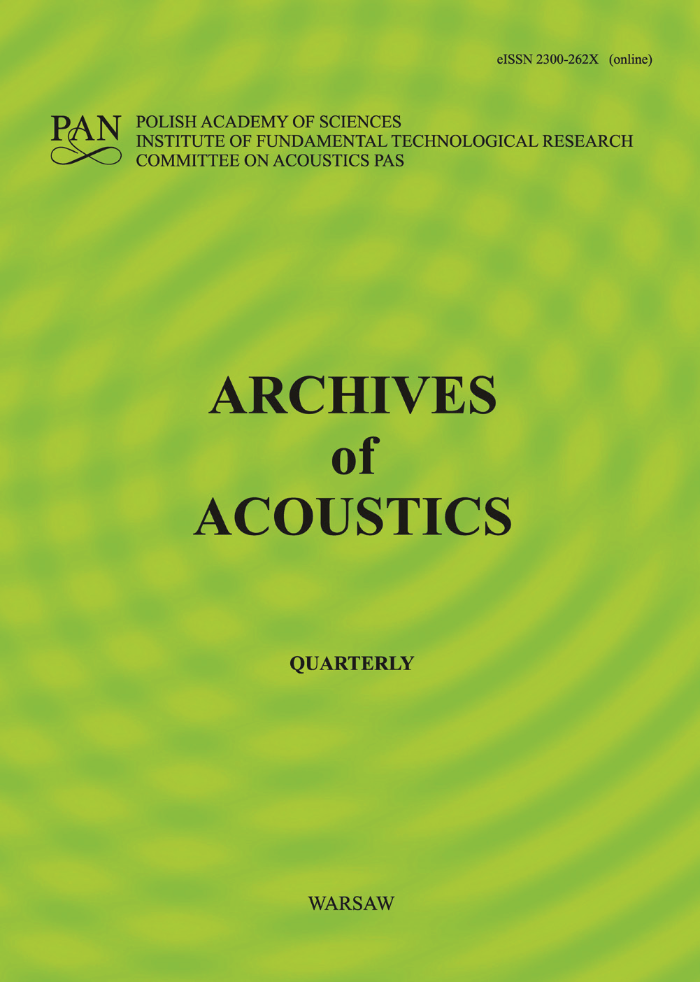Experimental and Computational Analysis on the Acoustic Performance of Side Outlet Muffler with Semi-Circular Baffles
Abstract
In this study, the impacts of the inclusion of two semi-circular baffles and their orientations on the acoustic performance of the side outlet muffler have been investigated. The side outlet muffler has a circular simple expansion chamber with an axial inlet and a side outlet and two semi-circular baffles that have been placed inside the expansion chamber at different orientations. The axis of the outlet is at the right angle to the axis of the inlet. The acoustical investigation of the side outlet muffler with two semi-circular baffles is done using the plane wave analysis, the finite element method (FEM), and the two-load technique. Based on the orientations of the two semi-circular baffles, three different models of side outlet muffler with semi-circular baffles have been investigated. The plane wave analysis, FEM, and two-load method are applied to all models and it is found that analytical, computational, and experimental transmission loss (TL) are in good agreement. The analytical modelling successfully predicts the presence of semi-circular baffles in the form of peaks and troughs in the TL of side outlet muffler with semi-circular baffles before the cut-off frequency and thus proves its effectiveness. Among all the models, model_2 gives 42 % higher TL than model_1 and model_3 shows 16.20 % higher TL than model_2. Hence, model_3 proves to be the best design for the side outlet muffler with semi-circular baffles in the attenuation of noise. The model_3 is effective for 1030 Hz–1480 Hz, 1500 Hz–1570 Hz, and 1640 Hz–2400 Hz frequency sound waves. The TL curve, sound pressure contours for model_3, and the band power variation in the 1/3 octave band for all the models have also been presented.
Keywords:
band power, finite element method, semi-circular baffles, side outlet muffler, sound pressure level, transmission loss, two-load methodReferences
- Åbom M. (1990), Derivation of four pole parameters including higher order mode effects for expansion chamber mufflers with extended inlet and outlet, Journal of Sound and Vibration, 137(3): 403–418, https://doi.org/10.1016/0022-460X(90)90807-C.
- ANSYS (2022), Mechanical APDL: 2022R1, Acoustics – Acoustic Fundamental, Chapter 8, Ansys workbench help documentation.
- Chang Y.-C., Chiu M.-C. (2014), Optimization of rectangular multi-chamber plenums equipped with multiple extended tubes using the BEM, neural networks, and the genetic algorithm, Journal of Mechanics, 30(6): 571–584, https://doi.org/10.1017/jmech.2014.66.
- Cheng C.Y.R., Wu T.W. (1999), Exhaust muffler design and analysis using a boundary element methodbased computer program, SAE Technical Paper 1999-01-1661, https://doi.org/10.4271/1999-01-1661.
- Das S. et al. (2022), A novel design for muffler chambers by incorporating baffle plate, Applied Acoustics, 197: 108888, https://doi.org/10.1016/j.apacoust.2022.108888.
- Davis D.D., Stokes G.M., Moore D., Stevens G.L. (1954), Theoretical and experimental investigation of mufflers with comments on engine-exhaust muffler design, National Advisory Committee for Aeronautics, Report 1192, https://ntrs.nasa.gov/api/citations/19930092208/downloads/19930092208.pdf.
- Done V. et al. (2014), Muffler design for a refrigerator compressor, International Compressor Engineering Conference.
- Elsayed A., Bastien C., Jones S., Christensen J., Medina H., Kassem H. (2017), Investigation of baffle configuration effect on the performance of exhaust mufflers, Case Studies in Thermal Engineering, 10: 86–94, http://doi.org/10.1016/j.csite.2017.03.006.
- Fairbrother R., Varhos E. (2007), Acoustic simulation of an automotive muffler with perforated baffles and pipes, SAE Technical Paper 2007-01-2206, https://doi.org/10.4271/2007-01-2206.
- Fan W., Guo L.X. (2016), An investigation of acoustic attenuation performance of silencers with mean flow based on three-dimensional numerical simulation, Shock and Vibration, 2016: 6797593, https://doi.org/10.1155/2016/6797593.
- Gorazd Ł. (2021), Experimental determination of a reflective muffler scattering matrix for single-mode excitation, Archives of Acoustics, 46(4): 667–675, https://doi.org/10.24425/aoa.2021.139643.
- Gupta A.K. (2016a), Comparison of noise attenuation level by a convergent and divergent cylindrical duct with space constraints, International Journal of Scientific Research in Science, Engineering and Technology, 2(2): 778–781.
- Gupta A.K. (2016b), Observation for transmission loss by applying multiple baffle plates on single expansion chamber: A simulation approach, International Journal of Engineering Research and Modern Education, 1(1): 2455–4200, http://ijerme.rdmodernresearch.com/wp-content/uploads/2016/04/28.pdf.
- Gupta A.K., Tiwari A. (2015), Measurement of sound transmission loss on straight and zigzag perforated concentric tube muffler with constant porosity, International Journal on Emerging Technologies, 6(2): 35–40.
- Horoub M. (2011), Acoustic noise control using multiple expansion chambers, Ph.D. Theisis, King Fahd University of Petroleum and Minerals, Saudi Arabia.
- Hua X., Herrin D.W. (2013), Practical considerations when using the two-load method to determine the transmission loss of mufflers and silencers, SAE International Journal of Passenger Cars – Mechanical Systems, 6(2): 1094–1101, http://doi.org/10.4271/2013-01-1881.
- Igarashi J. (1958), Fundamentals of Acoustical Silencers (I): Theory and Experiment of Low Pass Filters, Aeronautical Research Institute, University of Tokyo. Aeronautical Research Institute.
- Ih J.G., Lee B.H. (1985), Analysis of higher order mode effects in circular expansion chamber with mean flow, The Journal of the Acoustical Society of America, 77(4): 1377–1388, https://doi.org/10.1121/1.392029.
- Ih J.-G., Lee B.-H. (1987), Theoretical prediction of the transmission loss for the circular reversing chamber mufflers, Journal of Sound and Vibration, 112(2): 261–272, https://doi.org/10.1016/S0022-460X(87)80194-3.
- Ih J.-G. (1992), The reactive attenuation of rectangular plenum chamber, Journal of Sound and Vibration, 157(1): 93–122, https://doi.org/10.1016/0022-460X(92)90569-J.
- Jayaraman K., Yam K. (1981), Decoupling approach to modeling perforated tube muffler components, The Journal of the Acoustical Society of America, 69(2): 390–396, https://doi.org/10.1121/1.385465.
- Jeong U.-C., Kim J.-S., Kim Y.-D., Oh J.-E. (2015), Noise reduction of the automobile multi-mode muffler using differential gap control and neural network control, [in:] Proceedings of the Institution of Mechanical Engineers, Part D: Journal of Automobile Engineering, 230(7): 928–941, https://doi.org/10.1177/0954407015597080.
- Kulkarni M.V., Ingle R.B. (2018), Finite element analysis of double expansion chamber reactive muffler with side outlet, International Journal of Research and Analytical Reviews, 5(4): 758–764.
- Le Roy T.W. (2011), Muffler characterization with the implementation of the finite element method and experimental techniques, MSc. Thesis, Michigan Technological University, https://doi.org/10.37099/mtu.dc.etds/381.
- Lee J.K., Oh K.S., Lee J.W. (2019), Methods for evaluating in-duct noise attenuation performance in a muffler design problem, Journal of Sound and Vibration, 464: 114982, https://doi.org/10.1016/j.jsv.2019.114982.
- Mimani A., Munjal M.L. (2011), Transverse plane wave analysis of short elliptical chamber mufflers: An analytical approach, Journal of sound and vibration, 330(7): 1472–1489, https://doi.org/10.1016/j.jsv.2010.09.035.
- Mimani A., Munjal M.L. (2012), Acoustical behavior of single inlet and multiple outlet elliptical cylindrical chamber muffler, Noise Control Engineering Journal, 60(5): 605–626, https://doi.org/10.3397/1.3701036.
- Mundhe V., Deore E. (2015), Design and optimization of perforated muffler in an automobile exhaust system, International Journal of Applied Research, 1(8): 390–395.
- Munjal M.L. (1975), Velocity ratio-cum-transfer matrix method for the evaluation of a muffler with mean flow, Journal of Sound and Vibration, 39(1): 105–119, https://doi.org/10.1016/S0022-460X(75)80211-2.
- Munjal M.L. (1987), A simple numerical method for three-dimensional analysis of simple expansion chamber mufflers of rectangular as well as circular cross-section with a stationary medium, Journal of Sound and Vibration, 116(1): 71–88, https://doi.org/10.1016/S0022-460X(87)81321-4.
- Munjal M.L. (1997), Plane wave analysis of side inlet/outlet chamber mufflers with mean flow, Applied Acoustics, 52(2): 165–175, https://doi.org/10.1016/S0003-682X(96)00053-9.
- Mohamad B., Karoly J., Zelentsov A., Amroune S. (2021), Investigation of perforated tube configuration effect on the performance of exhaust mufflers with mean flow based on three-dimensional analysis, Archives of Acoustics, 46(3): 561–566, https://doi.org/10.24425/aoa.2021.138148.
- Narayana T.S.S., Munjal M.L. (2005), Prediction and measurement of the four-pole parameters of a muffler including higher order mode effects, Noise Control Engineering Journal, 53(6): 240–246, https://doi.org/10.3397/1.2839259.
- Reddy K.P.K., Fatima S., Mohanty A.R. (2017), A new sound quality metric for the design of engine exhaust mufflers, Proceedings of the Institution of Mechanical Engineers, Part D: Journal of Automobile Engineering, 232(2): 254–263, https://doi.org/10.1177/0954407017696608.
- Seybert A.F., Cheng C.Y.R. (1987), Application of the boundary element method to acoustic cavity response and muffler analysis, Journal of Vibration, Acoustics, Stress, and Reliability in Design, 109(1): 15–21, https://doi.org/10.1115/1.3269388.
- Siano D., Auriemma F., Bozza F. (2010), Pros and cons of using different numerical techniques for transmission loss evaluation of a small engine muffler, SAE Technical Paper 2010-32-0028, https://doi.org/10.4271/2010-32-0028.
- Sullivan J.W. (1979), A method of modeling perforated tube muffler components. I. Theory, The Journal of the Acoustical Society of America, 66(3): 772–778, https://doi.org/10.1121/1.383679.
- Sullivan J.W., Crocker M.J. (1978), Analysis of concentric tube resonators having unpartitioned cavities, The Journal of the Acoustical Society of America, 64(1): 207–215, https://doi.org/10.1121/1.381963.
- Tao Z., Seybert A.F. (2003), A review of current techniques for measuring muffler transmission loss, SAE Technical Paper 2003-01-1653, https://doi.org/10.4271/2003-01-1653.
- Vishwakarma S.K., Pawar S.J. (2021), Simulation studies on the transition from simple expansion chamber muffler to tapered expansion chamber muffler, [in:] Advances in Fluid and Thermal Engineering. Lecture Notes in Mechanical Engineering, pp. 389–398, https://doi.org/10.1007/978-981-16-0159-0_34.
- Vishwakarma S.K., Pawar S.J. (2022), Analytical and computational acoustic modeling of side outlet muffler and its extension in the modeling of tapered side outlet muffler, Archives of Acoustics, 47(4): 491–499, https://doi.org/10.24425/aoa.2022.142893.
- Vishwakarma S.K., Pawar S.J. (2024), Analytical, computational, and experimental investigations on the impact of side outlet on the simple expansion chamber with axial outlet, Noise & Vibration Worldwide, 55(9–10): 473–480, https://doi.org/10.1177/09574565241278721.
- Wang C.-N. (1999), A numerical analysis for perforated muffler components with mean flow, Journal of Vibration and Acoustics, 121(2): 231–236, https://doi.org/10.1115/1.2893969.
- Xiang L., Zuo S., Wu X., Zhang J., Liu J. (2016), Acoustic behaviour analysis and optimal design of a multi-chamber reactive muffler, Proceedings of the Institution of Mechanical Engineers, Part D: Journal of Automobile Engineering, 230(13): 1862–1870, https://doi.org/10.1177/0954407016630112.
- Yi S.-I., Lee B.-H. (1986), Three-dimensional acoustic analysis of circular expansion chambers with a side inlet and a side outlet, The Journal of the Acoustical Society of America, 79(5): 1299–1306, https://doi.org/10.1121/1.393709.
- Yu X., Tong Y., Pan J., Sun H., Cheng L. (2016), On the retrofitted design of a truck muffler with cascaded sub-chambers, Noise Control Engineering Journal, 64(5): 602–607, https://doi.org/10.3397/1/376404.
- Zhao B., Li H. (2022), Analysis of the influencing factors of the acoustic performance of the muffler considering acoustic-structural coupling, Archives of Acoustics, 47(4): 479–490, https://doi.org/10.24425/aoa.2022.142900.
- Zheng S., Kang Z., Lian X. (2012), Acoustic simulation for exhaust silencer of vehicle engine with combined one/three-dimensional approach, International Journal of Vehicle Design, 60(1/2): 57–70, http://doi.org/10.1504/IJVD.2012.049164.







